Some of the first tools early humans used were chopping tools. The earliest examples, made from various types of stone, were handheld, as their sheer size and weight precluded useful hafting. Later, more refined stone axes appeared hafted to wooden handles. As metallurgy was discovered and progressed through millennia, axes appeared in copper, then bronze, and finally, iron. Through it all, axe head shapes have remained remarkably consistent. Uses varied, depending on the environment, available resources, and relations with other people. So whether it is for procuring or preparing floral and faunal resources, clearing campsites and sustaining fire, or fighting fellow humans—some things have yet to change.
A specific category of the modern axe can be termed compact hatchet. Generally, a hatchet is a type of axe specifically designed for one-hand use. Compact versions have handles measuring approximately 10 inches or less, and companies often use descriptors like mini or small for corresponding models. These hatchets are distinct not only by their size but by their lighter weight and versatility; they are truly ideal, especially where space and weight factors persist.
Emphasizing optimal gear for overland and expeditionary use, we selected six high-quality examples that fall into the compact hatchet class. For this article’s nomenclature, the hatchet bit includes the toe, heel, and cutting edge. The shoulder is the backside of the handle, closest to the head. The knob comprises the enlarged or flared area at the end of the handle, specifically shaped so that the user’s hand will not slip during use.
Review and Field Testing
The best way to evaluate hand tools for field use is in the field. For this review, each product was put through similar user scrutiny to make valid, experience-based assessments. Three women and six men from various backgrounds were given the compact hatchets and told to make notes on ergonomics, efficiency, build quality and materials, special design features, sheaths, and any distinguishing X-factors (see sidebar at left)
Hults Bruk
Jonaker


Hults Bruk forge was founded in Sweden in 1697. Although they originally blacksmithed other items, they eventually turned to axes. The modern foundry is still in its original setting, right next to the stream that powered the company’s first water-driven forge hammers. The company changed hands over some generations, and eventually modernized in the 1800s with techniques and equipment borrowed from the United States. Just prior to the Second World War, they also developed specific tempering techniques to maintain a more robust cutting edge. Hults Bruk assigns two blacksmiths to work side by side, handcrafting each axe head to completion. They operate with less than 30 employees (they are owned by the Hultafors Group), but have 320 years of institutional knowledge refining metallurgy, manufacturing, and forging.
The Jonaker is the smallest hatchet in Hults Bruk’s premium axe lineup, with an overall weight of just over 1.5 pounds, and a length of 9.5 inches. Handmade, they clearly reflect the human touch. The forged head is refined and smooth, with minimal surface undulations often evident from traditional blacksmithing processes. The poll (the flat, rear portion of the head, sometimes referenced as the butt) has a consistent radius, a credit to the general blacksmithing and finishing details. The toe and heel (the corners or points at the ends of the cutting edge) on the Jonaker are symmetrical. The hatchet bit is well polished; the cutting edge is extremely sharp.
The handle, made from American hickory, arrives treated with linseed oil. The shoulder is ergonomic, with a clean contour that allows excellent feedback when gripped for light chopping duty or finesse splitting. The knob is subtly contoured and feels solid under grip. The handle is held securely in the axe head eye by a wooden wedge, which is then reinforced by a round steel wedge (section of tubular steel). Once assembled, the slightly protruding wedges and end of the handle are made flush by finishing passes on a wheel—a small but appreciated touch. Six lines of text are printed on the handle, stating obvious outcomes if the axe is not used safely. These can be sanded away.
The sheath is well constructed with thick, tanned leather, and is certainly adequate for the task. However, the retention system is very rudimentary. Once the bit is inserted into the sheath, a leather thong is slipped around the poll and then tightened by cinching the thong through holes on either side of the sheath. It is a bit awkward and requires two-handed operation.
Straight from the box, the Jonaker has a comfortable, broken-in feel. With its nice weight and balance, chopping, trimming limbs, shaving bark, or splitting kindling hardly seem to be chores. $144 | hultsbruk1697.se
Hultafors
Trekking Axe Mini Classic


The Hultafors Group manufactures various types of professional hand tools (hammers, sledges, chisels, pry bars, saws), and the purchase of the Hults Bruk foundry in the 1990s expanded their existing product line. The acquisition also allowed them to expand into the axe and hatchet marketplace, as evidenced by the Mini Classic.
Examined side by side, the Mini Classic and Hults Bruk Jonaker look strikingly similar, and both weigh in at just over 1.5 pounds. The Hultafors is slightly shorter in length at 9.25 inches though. Scrutinizing the heads, one would swear they were made in the same drop forge, and they would be right. Their marking stamps are exactly the same. The toe and heel of the Mini Classic are sharp and symmetrical, and the cutting edge is sharp. There are very minor differences in the cutting edge bevel between the two, probably reflecting subtle, idiosyncratic tendencies of different blacksmiths assigned to sharpening duty at the factory. They both chop and cut extremely well, and in its favor, the slightly longer bevel on the Hultafors cutting edge does make it sharper.
Presumably to establish a slightly lower retail price and not directly compete with the Jonaker, the Mini Classic has some noticeable differences. The handle shoulder profile is identical to the Jonaker and shaped from the same high-grade American hickory; however, the Mini Classic’s shorter handle does have a different belly and knob profile than its Hults Bruk cousin, and the tactile differences are very perceptible. Under heavy chopping, the Mini Classic’s grip and knob contour force the user’s hand to migrate toward the head, decreasing the efficacy of powerful chopping strokes during the downward swing. This isn’t an issue with finesse work, such as shaving bark or splitting small kindling, where the hand is better positioned closer to the head. It’s admittedly difficult to describe, but evaluators knew it when they felt it. This could be remedied by whittling and sanding to customize the grip, and larger hands might not experience the issue at all.
The Hultafors arrived from a North American distributor with minor surface rust on the hatchet head. On a forged iron tool like this, surface rust isn’t a showstopper, and it was cleaned in less than a minute. But just as this hatchet appeared to be from the rougher side of the tracks, its sheath rallied back. The Mini Classic comes with a thick, tanned leather sheath that encompasses nearly the entire head. The leather thong that holds the sheath to the head uses a much less finicky and more secure arrangement than the Jonaker. $92 | hultafors.com
Wetterlings
Compact Hatchet #104 (AKA “Buddy”)

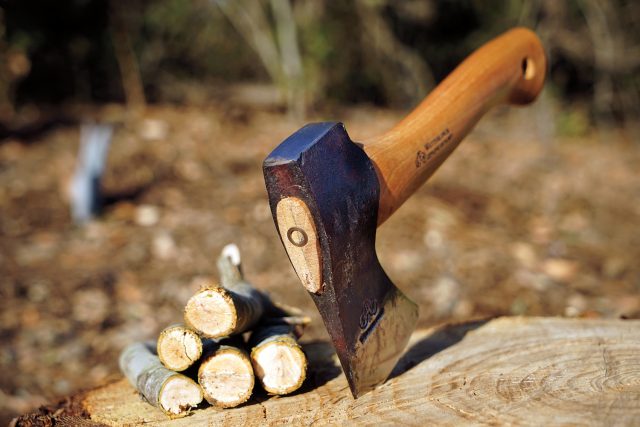
Like other Swedish axe-making companies, Wetterlings has changed hands a few times since it was founded in 1880. Similar to Hults Bruk, family members brought advanced manufacturing technologies back from the United States. Their zenith occurred during the grand days of the logging industry, when trees worldwide were felled by saw, axe, and hatchet. By the end of the 1970s, chainsaws and mechanized equipment like wheeled tree fellers rendered the axe, for large-scale commercial operations at least, nearly obsolete. Add in cheaper price (and quality) from overseas options along with fierce industry competition, and it’s clear why so many manufacturers had to close shop.
Wetterlings refused to tap out. They embraced their blacksmiths and started an axe handle manufacturing facility alongside their forges which helped keep them afloat. With the purchase of Wetterlings in 2016 by renowned Swedish axe makers Gränsfors Bruk’s AB, the two forges—competitors for more than 100 years—joined ranks to carry tradition into the future.
For their heads, Wetterlings sources recycled scrap iron that is turned into proprietary alloyed carbon steel blanks. Using time-honored heating, quenching, and hammering techniques, the heads are forged, hardened, and tempered. According to company specs, the Buddy weighs in at in at 1 pound, 9 ounces, and overall length is 10.25 inches (our test unit was closer to 10 inches). At the working end, the heel is slightly rounded, and the toe pointed. This could be an effect from the hand-sharpening process. Unlike the Hults Bruk and Hultafors, the Wetterlings’ poll is ground and then polished, thus eliminating the slightly uneven surface common on some forged tools. The factory edge comes razor sharp, and the polishing detail on the bit is superlative.
Wetterlings hafts an American hickory handle. Of the products reviewed here, the Buddy’s handle is the most refined. It’s comfortable held up by the head for subtle work, mid-shaft for light splitting, or down at the knob for heavy chopping. In the eye, a tubular steel wedge reinforces the customary wooden one. On our test unit, the wedge protrudes slightly from the handle. This didn’t affect function, but it was slightly abrasive. Examining this exceptional hatchet in entirety, one could surmise that this detail was inadvertently overlooked.
The vegetable-tanned leather sheath is by far superior to the other products reviewed regarding look, feel, and build quality. The rivets are closed on both sides (the only leather sheath in this review to have these) and the snap is very robust. One could envision this sheath holding up generations later.
Wetterlings offers a 20-year warranty on their axes. Their general philosophy is that one does not really own an antique axe forge. They belong to a common industrial heritage, and it is the current owner’s responsibility, much like a museum curator, to preserve and transfer the legacy of generational knowledge to those yet to come. $114 | wetterlings.com
Gransfors Bruk
Hand Hatchet


Gränsfors Bruk is probably the best known of the surviving Swedish axe forges. Not as old as Wetterlings, but they take pride in build quality and tradition. Gränsfors Bruk has also assumed the roles of educator, promoter, and general keeper of the Swedish forged axe faith. Their axes come with an informational booklet, The Axe Book, that you will not discard. Their heads bear the initials of the blacksmith who forged them. Besides copious information they have available (e.g., making a fire outdoors), Gränsfors Bruk provides a bibliography that spans topics such as axe history and use, forestry, technological development, and metallurgy. They certainly take axe making to the next level.
This hatchet is the smallest in their Forest series with an overall length of 9.5 inches. Long, curved cutting edges and horizontal, extended axe heads typify this lineup. The DG stamp on the review unit indicates Daniel Gräntz forged that tool. This connection, maker to user, adds a welcome human touch. There is no weight stamp, but their specifications indicate 1.3 pounds with the handle. The cutting edge and bit are clean and well polished. Out of the box, it is extremely sharp. The surface finish is very similar to the Hults Bruk and Hultafors. It’s rough around the edges (excluding the cutting edge) with a fairly uneven surface, and certainly has a hand-forged appearance. The poll has an undulating surface and is lightly polished. One of the lugs (the ears that help secure the head to the handle) has a noticeable gouge remnant from the forging process.
The handle is hickory and stands out among the others as it does not have a smooth surface. One side of the handle has a stippled effect on the wood, rendering the surface rough. It’s a bit odd as this effect is only on one side of the handle. I own a Gränsfors Bruk splitting axe with, as they call them, “circular grooves” toward the knob end. Those found on this hatchet appear random, almost pecked, or part of the wood. The wedge holding the handle into the eye is a wooden type and well finished. The sheath is simple, with a strap and snap to secure. The leather is vegetable tanned, but not as thick or durable as the Wetterlings.
Although not the prettiest axe, this hatchet performs. I did find the handle unnecessarily abrasive. It has the longest cutting edge of the test group and consequently chops and limbs very well, but this also means it’s easier to cut fingers. It works great for small kindling, and comes with a 20-year warranty. $134 | gransforsbruk.com
Gransfors Bruk
Small Hatchet #410
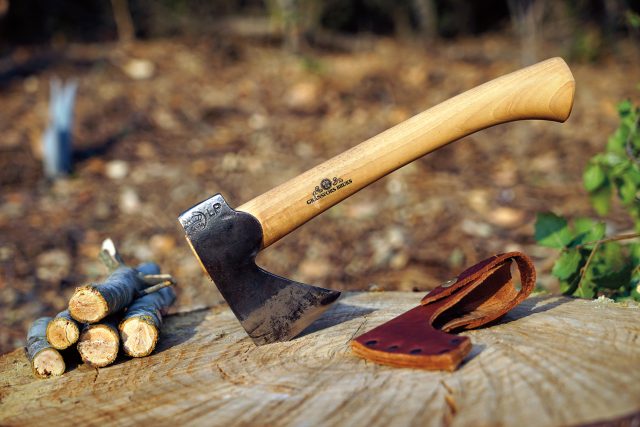

With a brief version of Gränsfors Bruk’s illustrious story described in the previous review, we turn to their unique field instrument: model #410 (sometimes listed as the Mini Hatchet, or Mini Belt Hatchet). I first held one shortly after a colleague bought it at an estate sale, along with numerous other Swedish axes. The first descriptor to mind was “cute.” It looks like a miniature version of their full-size, two-hands-required Scandinavian Forest and American Felling axes. Perhaps this mini was a shop display model, or intended exclusively for a Scandinavian förskola (preschool) class? After establishing this as legitimate adult kit, the giggles faded and we immediately put it to use.
Lennart Pettersson conceived this hatchet at Gränsfors Bruk. An avid fisherman and professional blacksmith, Pettersson envisioned a very lightweight yet time-honored design that would be ideal for backpacking, angling, or light camp and trail duties. The head appears to have spent more time on the finishing wheel than the other Swedish hatchets reviewed here. Or simply, small aesthetic details were attended during the manufacturing process. No matter, the cutting edge arrives extremely sharp, and along with the bit, is beautifully polished. The poll is also polished and has a slight curve, which Pettersson felt would be ideal for knocking out fish once reeled in. Pettersson’s initials (LP) are stamped on one side. Gränsfors weighs it in at 0.7 pounds with the handle, the lightest in our lineup.
The hickory handle, with its straighter felling axe profile, is sanded glassy smooth. Due to its smaller handle diameter, different hold variations such as a saber or hammer grip feel right at home. There is a continual ergonomic agreement between the hand and handle, no matter where or how one grips, even with a reversed grip while using the poll. With its lighter head and nimble weight and balance, this hatchet exceeded everyone’s expectations.
The handle is secured into the shaft-hole with a wooden wedge, and overall length is just over 10 inches. The handle protrudes slightly from the eye, but has a clean cut and smooth finish. Due to its lighter weight coupled with the handle length and design, the user doesn’t fatigue under sustained duty use such as preparing kindling or limbing small branches. There is a clear sense of less-is-more when working with this tool. All evaluators independently described this hatchet as “handy,” which reveals a lot regarding its superior practical applications.
The sheath is from vegetable-tanned leather, and like that accompanying the Gränsfors hand hatchet, is not as well built as the Wetterlings. Nevertheless, it accomplishes the task, and comes with a 20-year warranty. $159 | gransforsbruk.com
Winkler Knives II
Hunter’s Axe LT

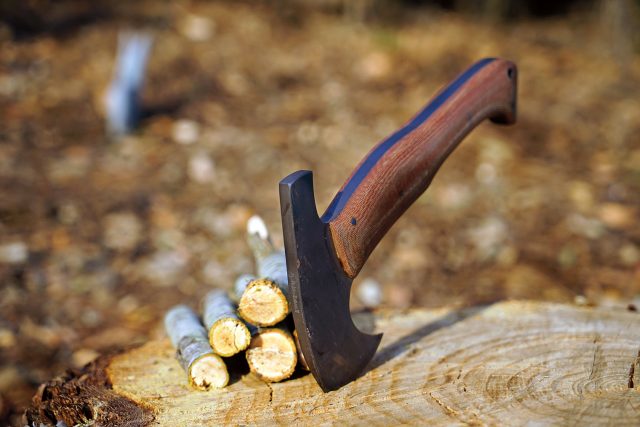
Master Bladesmith Daniel Winkler makes hand-forged knives and axes in North Carolina. Overland Journal reviewed several products in his Winkler Knives II line, made from stock removal rather than forging, in the Summer 2014 and Winter 2017 issues. The Hunter’s axe reviewed here supersedes his earlier version. With slight modifications to the original configuration, Winkler has brought this hand-finished design to its full potential.
Machine cut from a 0.25-inch piece of highly durable 80CrV2 sheet steel, the Hunter’s axe can be ordered in no-glare or rust-resistant finishes. The design departs in a few ways from more traditional forged steel hatchets. The head and tang are one solid piece and therefore a shaft hole, or eye, into which a handle would normally insert, is not required. Why does this matter? On the LT, the poll can be used as a full-force striking surface without concern for warping the eye or loosening the handle.
Likewise, the angle between the poll and handle makes this axe ideal for hooking and lifting actions, and hammering in or pulling out tent pegs. The bit design, with its extended heel and downward angled toe, make the cutting edge practical for dressing game and light camp duties where a knife might be needed.
Grip options, which comprise scales attached to the sides of the tang, include wood (curly maple or walnut), different Micarta colors, or reclaimed rubber. The handle has contours for different hand holds. The middle section doesn’t seem to have a sweet spot, but down against the knob or up against the hatchet head the user’s hand nestles comfortably. The handle cross section is rectangular rather than oval. This promotes a saber-type grip, where the user’s thumb can rest along the back of the handle, which helps with tasks that require a more dexterous touch. Winkler adds a ferrule in the toe of the knob for attaching a thong.
The axe comes with a felt-lined Kydex sheath, held in place by a length of heavy-duty elastic shock cord. Two web straps with MIL-SPEC Pull-the-Dot snaps allow for vertical belt carry or mounting on MOLLE-type gear. This reflects the axes unique design lineage and intended uses.
Weighing in at 1.5 pounds, it is the smallest product in the review with an overall length of 9 inches. The LT design harkens a combative tomahawk somewhere in its DNA. There is much less of a V-shaped profile in the bit and bevel, and consequently, it performs differently and removes less material than traditional hatchets under full-force chopping, splitting, or whittling. Around camp, it feels best in the finesse mode, preparing smaller kindling, trimming small tree limbs, hooking and moving items within the fire pit, field dressing game, and fixing tent pegs. All Winkler Knives II products come with a lifetime repair or replacement warranty. $450 (with no-glare finish) | winklerknives.com
Conclusions
These hatchets, descendants from a heritage that began with chipped stone tools, speak for themselves as tangible icons. From the Stone Age through the Iron Age and on to the Industrial Revolution, axes embody human innovation and a common legacy that took many millennia to develop.
The Hultafors Mini Classic and the Hults Bruk Jonaker have the same hatchet head, made by the same company. It’s clear that the Jonaker pays more attention to the small details. Maybe the 30 minutes of extra labor translates to the Jonaker’s higher price point. Nevertheless, the Hults Bruk and Hultafors are both solid for light chopping, limbing, and splitting.
The Wetterlings compact hatchet feels similar in hand to the Jonaker, but with a slightly more comfortable grip. Most evaluators agreed that the ergonomic handle of the Wetterlings translated to better efficiency. Everyone appreciated its craftsmanship. The handle is about 0.8 inches longer than the similarly styled Hultafors Mini Classic, Hults Bruk Jonaker, and the Gränsfors Bruk hand hatchet. The sheath is superior. Overall, this is a solid all-around hatchet.
The slightly longer cutting edge of the Gränsfors hand hatchet results in more chopping efficiency. In hand, it has a similar feel to the Hultafors Mini Classic. Though very versatile, some evaluators didn’t care for the handle contour or texture.
The Gränsfors small hatchet handle allows for varied grips, and there appears to be more attention to craftsmanship. It’s light and easy to stow, perfect for backpacking. It has the same cutting power as the heavier compact axes, but any required increase in stroke effort is not perceptible. The grip suits various hand sizes.
Winkler’s Hunter’s axe LT is a different approach than the Swedish contingency. However, forging knives and axes is Winkler’s other day job, so the LT is well versed. The LT’s 80CrV2 steel holds a keen edge. This hatchet has more of a multi-use feel than the others, and is the only one that could reliably hook, by its hammer poll, a blazing hot cast iron lid from the campfire.
All these hatchets are made with human hands guiding the process, so potential issues can be expected. One hopes that things like dried glue where the wedge was inserted (Gränsfors Bruk hand hatchet), a steel wedge slightly protruding from the shaft (Wetterlings), or splinters poking out of the wedge (Hultafors) would be caught at the forge. Such is the nature of certain handmade items.
The Wetterlings compact hatchet and the Gränsfors Bruk small hatchet had more positive responses. However, all of them have an heirloom quality. The differences among these compact hatchets are marginal, especially the Swedish contingent, and it will be the discerning user who favors one over the others. The Wetterlings Buddy came in as the overall favorite, with the Gränsfors Bruk small hatchet a close second. However, the Gränsfors was the solid choice for trail and backpacking, where weight is an issue, and all three women listed it as their go-to axe.
Many testers described the Winkler Knives II Hunter’s axe LT more as a great all-around camp tool, and found it ideal for stashing in an overland vehicle. The Gränsfors Bruk hand hatchet consistently took the middle ground, but was slightly edged out by the Wetterlings Buddy and Gränsfors Bruk small hatchet.
The Progressive Edge
Our team also reviews three modern hatchet designs suitable for overland applications.
By Scott Brady and Sarah Ramm
Outland
Multi-mission Axe
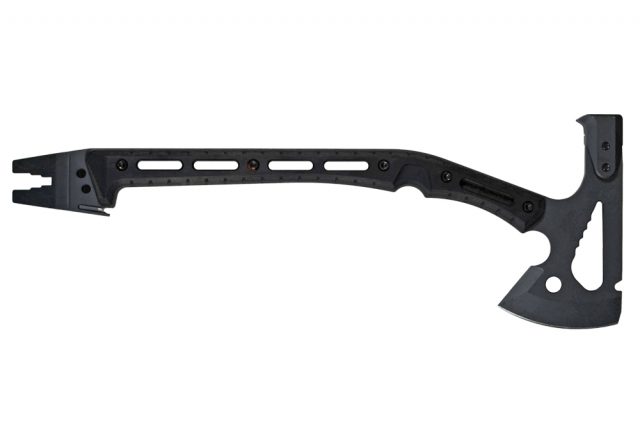
On rare occasions, something exceptional is designed—familiar, yet entirely new and thoroughly effective. Outland has managed to redefine this stalwart tool. The foundation of the Multi-Mission Axe (MMA) is a single hardened piece of S7 tool steel, selected for its ability to sustain prolonged impact and shock use. Designed initially for Special Forces everything personnel, the MMA is also ideal for overland travel, appropriate for everything from chopping firewood to cutting a seatbelt in the event of a rollover.
The head has a 4-inch cutting edge with an opposing hammer (with replaceable insert). The face provides for tightening or loosening a range of hex nut sizes. The handle grip runs the length of the body and is made from G10 fiberglass laminate with scaling and finger contours to ensure positive retention. With an overall length of 15 inches, the knob end features a pry tool with a sheet metal cutter. Included is a multi-mount, multi-position sheath that holds the 2.5-pound MMA using an internal latch and two BioThane webbing straps. With an emphasis on material quality and production precision, this axe is designed to last a lifetime and maybe even save a life in the process. (SB) $425 | outlandequipment.com
Fiskars
X7 Hatchet
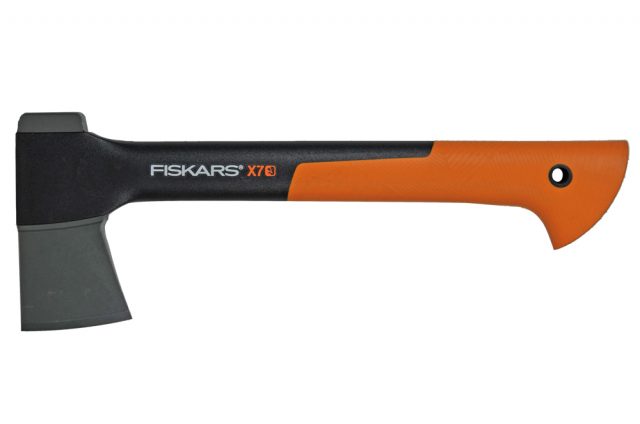
Sometimes keeping it simple is the best solution, which is where the Fiskars X7 hatchet comes in. Fiskars has been in the ironwork business since it was founded in 1649, and has always set out to create functional and sustainable products for its customers. The company is no newcomer to blades, and is so confident in their work that they offer a lifetime guarantee.
About 5 years ago, our camp kit was in need of a new hatchet, and we chose this one because of the low price point and trusted household name. It has been tasked with chopping wood for countless fires and hammering in tent stakes since we can never remember to bring a mallet. Even though the way we use this hatchet borders on abuse, it has never let us down and continues to keep a sharp edge. It has been so useful, we bought a second one (pictured) for the other Jeep.
The overall length of the X7 is 14 inches, and it weighs in at 1.4 pounds. The blade is coated with a low-friction finish which helps keep it from getting stuck in the wood, and the 12-inch plastic FiberComp handle is advertised as being strong as steel. While the handle is lightweight and won’t split from negligence or age, it tends to cause more arm fatigue and is not quite as balanced as a traditional wood-handled hatchet. Unlike other budget hatchets, the flared end of the handle keeps it from slipping out of your hand during use. (SR) $25 | fiskars.com
SOG
Camp Axe

Inspired by the 5th Special Forces Group, the Studies and Observation Group (SOG) was a Vietnam-era clandestine joint services unit operating throughout Southeast Asia. MACV-SOG carried a unique combat bowie knife for many of their missions, enhancements to that original design becoming the first product of designer Spencer Frazer and the SOG knife company. Those ideals have continued to today, inspiring one of their new est products, the Camp Axe.
Intended for chopping and hammering, this stainless steel tool weighs just over a pound and is nearly 12 inches long with a 3.1-inch blade length. The black handle material is molded from glass-reinforced nylon and provides a positive grip in multiple positions along the shaft. Grooves help to improve retention, and a pre-drilled hole in the end allows for a lanyard. The head is replaceable using two hex bolts, and the opposing end provides a hammer for pounding tent stakes into the ground or bent wheels back into shape. A rubber sheath is included in the package and allows for some protection while using the axe as a hammer. The low price is particularly impressive given the quality of materials and lifetime warranty. (SB) $54 | sogknives.com


